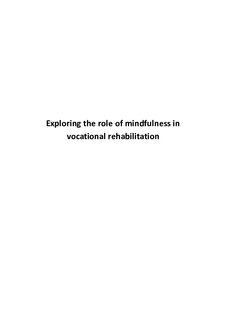| dc.contributor.author | Vindholmen, Solveig | |
| dc.date.accessioned | 2017-10-16T07:20:55Z | |
| dc.date.available | 2017-10-16T07:20:55Z | |
| dc.date.issued | 2017 | |
| dc.identifier.isbn | 978-82-7117-851-2 | |
| dc.identifier.issn | 1504-9272 | |
| dc.identifier.uri | http://hdl.handle.net/11250/2460190 | |
| dc.description | Doctoral thesis, Faculty of health and sport science, University of Agder 2017 | nb_NO |
| dc.description.abstract | Background Vocational rehabilitation is increasingly used to facilitate a successful
return to work (RTW) after long-term sick leave. Some vocational rehabilitation
programs incorporate mindfulness training, suggesting that mindfulness is an
effective tool for successful RTW. However, whether mindfulness enhances work
ability (WA) and RTW rates has not yet been investigated.
Main aims To investigate whether mindfulness is a predictor of increased WA and
successful RTW after a multidisciplinary vocational rehabilitation program (MVRP),
and to explore the mediating influences of mindfulness in the relationship between
personal health factors and WA.
Methods The project featured one retrospective cohort study and one prospective
cohort study. The retrospective cohort study included 80 former participants (from
2008 to spring 2011) in the MVRP. Self-report measures were used to measure work
status, WA, quality of life (QOL), and mindfulness. The prospective cohort study was
conducted with 74 active participants in an MVRP in the period autumn 2011–
autumn 2012. Self-report measures of functional health and psychological
functioning were collected. In addition to a standard logistic regression analysis
procedure, a bias-corrected bootstrapping technique was used to test the
hypothesized indirect effects.
Main results Results from the retrospective cohort study suggested that mindfulness
was indirectly related to RTW through QoL. The covariates WA and education level
significantly predicted RTW. Furthermore, mindfulness significantly predicted
successful RTW but only for the “high-educated” participants. Results from the
prospective study suggest that the outcome of an MVRP is affected by pain intensity
and sense of mastery at baseline. High pain intensity and low sense of mastery
significantly predicted an unsuccessful WA response to the MVRP. Furthermore, the
results revealed that enhancement of mindfulness during the course of the program
significantly predicted a successful WA response. In addition, decreased personal
burnout and enhanced self-esteem were both unique predictors of a positive WA
response. Mediation analysis showed that mindfulness mediated the effects of
personal burnout and self-esteem on the participants’ WA response.
Conclusion The data in the retrospective cohort study demonstrate that mindfulness
may be a usefull tool applied in the context of vocational rehabilitation, suggesting that mindfulness may enhance RTW and WA via QOL. Furthermore, for “higheducated”
participants, mindfulness independently predicts RTW. We conclude that
enhancement of education and qualifications for the labor market should be the
highest priority for “low-educated” people on long-term sick leave. Data from the
prospective cohort study indicate that enhancing the skills of mindfulness may be
useful when aiming to increase WA. However, not all individuals respond positively to
the MVRP in terms of improved WA. In particular, unfavorable WA responses were
detected in participants who reported high pain intensity and a low sense of mastery
at baseline. We conclude that it still is a challenge to understand the factors that
distinguish responders to MVRPs from nonresponders, and thus, further research is
required. | nb_NO |
| dc.language.iso | eng | nb_NO |
| dc.publisher | Universitet i Agder / University of Agder | nb_NO |
| dc.relation.ispartofseries | Doctoral dissertations at University of Agder; | |
| dc.relation.ispartofseries | ;157 | |
| dc.rights | Attribution-NonCommercial-NoDerivatives 4.0 Internasjonal | * |
| dc.rights.uri | http://creativecommons.org/licenses/by-nc-nd/4.0/deed.no | * |
| dc.title | Exploring the role of mindfulness in vocational rehabilitation | nb_NO |
| dc.type | Doctoral thesis | nb_NO |
| dc.subject.nsi | VDP::Samfunnsvitenskap: 200::Psykologi: 260::Sosial- og arbeidspsykologi: 263 | nb_NO |
| dc.source.pagenumber | [196] p. | nb_NO |

